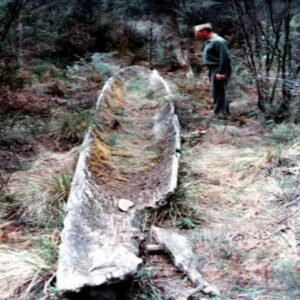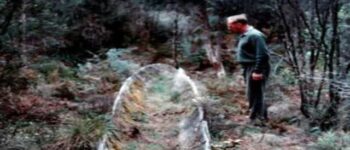1967: Opepe Canoe Rescue
November 27, 2022
By AHNZ
 In Taupo History news this week we see that Taupo Museum is congratulating itself for re-mounting the Opepe Canoe for the third time. Goodness knows how much it cost the taxpayer. Whereas, the first time the ‘waka’ was conserved and mounted it was all done by the community for free.
In Taupo History news this week we see that Taupo Museum is congratulating itself for re-mounting the Opepe Canoe for the third time. Goodness knows how much it cost the taxpayer. Whereas, the first time the ‘waka’ was conserved and mounted it was all done by the community for free.
The Opepe Canoe appears to date from the 1850s. Was made of a single totara log at Ranginui, Opepe, not far from where it once was a tree although the stump could not be found in the 1960s. The understanding is that the canoe was never intended for the water but made to be a property marker to establish and maintain Maori land claims back in the day.
It’s a bit annoying that the Taupo Museum and Taupo & Turangi Herald are tooting their own horn without any credit for those who did the real work of saving this canoe. If anything, I’m sensitive to a criticism of men like Trevor Hosking who “exposed to the elements for years” this mighty bit of history as if the old generation had done wrong. In fact, the 1960s historical community not only located, rescued, and preserved the canoe but they extracted it from 100 years of exposure to the elements!
“An important restoration project has ensured the Opepe waka, the centrepiece of the Tūwharetoa Gallery at the Taupō Museum, can be admired for years to come. The 15m waka, made from one mighty totara log, was found at Opepe in the 1950s and was outside, exposed to the elements, for years next to the Taupō Police Station.” –Waka preserved for future generations, Taupo & Turangi Herald, NZ Herald (November 2022)
“A Rotorua logging contractor, Mr J. J. Wood and his workmen found the canoe some years ago but kept its existence secret in case vandals destroyed it…There is no sign in the vicinity of the stump of a tree from which it could have been made.” – Rotorua Post (28 October, 1967,) discover.stqry.app
“The elders approved and the Historic Places Trust said they would cover costs. However the community got together and with a little persuasion here and there, we ended up with absolutely no costs to us at all.” – p134, Harrington (2007)
The canoe was stumbled upon the 1950s by a Mr Wood (go figue) and his logging crew in the scrub during a pig hunt but kept secret for its own safety¹. However, the local Maoris already knew so when it came up the local historian, Hosking knew who to ask.
Hosking organised the conservation team. A local woman and her daughter pitched in. A scrub-crushing contractor nearby came to build a track to the canoe. Hosking, a carpenter, spent a weekend reinforcing the canoe for transport. A house removalist and some forestry workers moved the canoe to Taupo. Surplus concrete was given for free from the Aratiaia Power project for the new ‘customised’ mounting.
 In 2022 “new custom-made supports installed” for the third time since the supports used had been ‘custom’ every other time too. In the first instance Hosking, perhaps single-handedly, jacked the canoe up and lowered it onto the concrete supports he had made. “Once that was done, I could start breathing again,” he says.
In 2022 “new custom-made supports installed” for the third time since the supports used had been ‘custom’ every other time too. In the first instance Hosking, perhaps single-handedly, jacked the canoe up and lowered it onto the concrete supports he had made. “Once that was done, I could start breathing again,” he says.
In 2004 the Historic Places Trust built a roof over the canoe. It may not have needed it since the canoe had already made it 150 years without and was still in pretty good condition when found. Hosking argues that another of his preservation efforts, the historic wooden water trough at Opepe, was dried out and split because of lack of water. Maybe the roof did more harm than good?
Then, on 3 December 2005, “dozens of helpers and electronic jacks” with a crane and a truck shifted the canoe to the interior of the Taupo Museum. Hosking seemed amused at how much fuss it took to replicate his 1967 effort, the “great collection of cranes, girders, slings and trucks with men to match was needed..” he notes.
In November 2022 a new lot did it all again, “That was completed last week with the waka blessed, raised, treated and new custom-made supports installed. Taupō Museum displays officer Piata Winitana-Murray says it was a long time coming after the Covid-19 pandemic caused several delays. “We were going to start in 2020 and now that it’s done it is a little surreal.””
It is a little surreal. For one thing, it seems like everything our post-war amateur historical community did needs to be denigrated and redacted. Trevor Hosking in particular completed amazing projects over the years that now get short shrift as seen in again in this Herald article. The Turangi Museum he created? Mothballed and looted. His observations about Moa Hunter cave art? Don’t want to know. His preservation of Orari Gorge Station at Geraldine was side-lined. His re-building of McDonnell’s Redoubt at Lake Rotoaira is not celebrated, instead the Maori replica Te Porere redoubts are marked down by Heritage NZ.
“What happened here with Invercargill also helps me understand Rotorua’s situation. Why would anyone give the museum manager job to pop singer Lizzie Marvelly? She has no knowledge or skill or passion for our history. What she does have is a very particular set of skills at extracting grants money (called a career) for the arts and lots of contacts too. That’s what museum directors are these days and our heritage is placed in their hands.” – AHNZ (2021)
For another thing, if I’m being skeptical of the latest ‘customised’ re-seating of this canoe, it matches up with what we have seen about museum economics. Museum Directors/Managers such as Lizzie Marvelly (Rotorua) and Wayne Marriott (Invercargill) are prized for their skills are pulling grant money and that’s why they get their jobs. Grant money is given for Current Thing hot topics or supposedly deteriorating artifacts that need a fast cash bandaid. Deterioration thus becomes desirable because it can be capitalised (Google the term ‘Moral Hazard.’) It may be that the Opepe Canoe being moved around and conserved, along with the little circus of doing so, is another example of this activity.
—
1 Putting 2 and 2 together here. Hosking says the canoe was discovered by a ‘neighbour’ on a pig hunt. Rotorua Post says it was Mr Wood and his crew who found it
Ref. A Museum Underfood, Alison Harrington (2007)
Image ref. discover.stqry.app
 Like Comment Share
Like Comment Share





